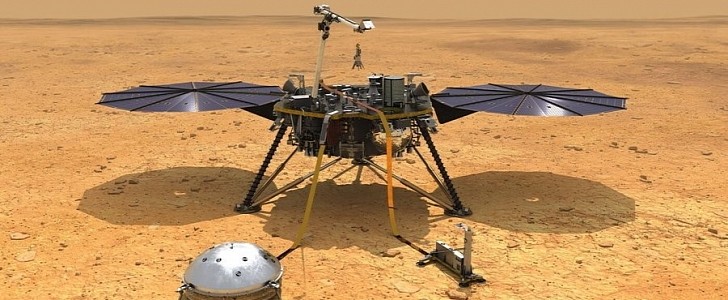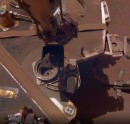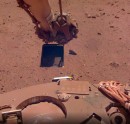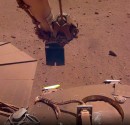Although Mars has a much thinner atmosphere than Earth, it still has some pretty strong winds that can lift up the fine particles settled on its surface and create dust storms. And even if they're a common occurrence on the Red Planet, sometimes these storms turn out to be the solar-powered spacecraft's biggest enemies.
Last week, a large sand storm hit the region where NASA's InSight lander is currently located. As a result, InSight's solar panels didn't get enough sunlight, and the spacecraft was forced to go into safe mode. This means all of its non-essential systems were shut down to preserve energy.
That's no good news for the lander, which already has its panels covered with some dust. Earlier this year, InSight tried to remove some of the fine particles by scooping up dirt with its robotic arm and placing it on one panel.
This interesting method actually worked. The wind kicked off the sand, which carried along with it some fine dust, ultimately cleaning up the panels and giving the spacecraft an energy boost. However, that's not to say that everything is dust-free now.
Particles continued to accumulate, making scientific operations more difficult as the available energy decreased. The current dust storm that forced InSight to go into safe mode was spotted by NASA's Mars Reconnaissance Orbiter. Using its onboard camera, the orbiter takes images that sometimes show how dust is taking over the Red Planet.
But there's some good news too. Data indicates that the storm is slowly dissipating. On January 10th, the InSight team was able to communicate again with the lander. This allowed them to check its power levels, which, although low, were stable.
The team hopes to be able to command InSight to exit safe mode next week. This will allow the lander to continue its scientific operations on the Red Planet.
That's no good news for the lander, which already has its panels covered with some dust. Earlier this year, InSight tried to remove some of the fine particles by scooping up dirt with its robotic arm and placing it on one panel.
This interesting method actually worked. The wind kicked off the sand, which carried along with it some fine dust, ultimately cleaning up the panels and giving the spacecraft an energy boost. However, that's not to say that everything is dust-free now.
Particles continued to accumulate, making scientific operations more difficult as the available energy decreased. The current dust storm that forced InSight to go into safe mode was spotted by NASA's Mars Reconnaissance Orbiter. Using its onboard camera, the orbiter takes images that sometimes show how dust is taking over the Red Planet.
But there's some good news too. Data indicates that the storm is slowly dissipating. On January 10th, the InSight team was able to communicate again with the lander. This allowed them to check its power levels, which, although low, were stable.
The team hopes to be able to command InSight to exit safe mode next week. This will allow the lander to continue its scientific operations on the Red Planet.








